Sampling of Archived Blog Posts
For the latest news, follow me on Twitter @LindaSuePark, or scroll down to see tweets at left.
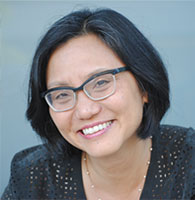
Photo by Sonya Sones
Twitter Feed
News Archive
The choices we make

I want to write here about looking at our own stuff. But first, a story.
As a student in the inaugural Women’s Studies course at my university, I could hardly wait for classes to begin. A group of professors and grad students had dedicated years to lobbying for a Women’s Studies program; this course was the first to be approved by the administration.
During the opening lecture in the overflowing auditorium, we learned how hard the group had worked to make the course truly different. The syllabus consisted entirely of works written by women. Authority would be decentralized: Our study groups would be headed by a cooperative panel of three teaching assistants, not just one. Our written work would be read and critiqued by the three TAs, who would collectively agree on the grade.
I felt like I was not just witnessing history, but actually participating in real societal change. For our first assignment, we were asked to write about why we had chosen to enroll in the course, and what we hoped to gain from it. Our responses, we were told, would help shape the entire program.
I took the instructors at their word. My essay expressed enthusiasm for the course, and then asked a question: Why was every reading on the syllabus written by a white woman? I had hoped to learn about global efforts toward justice for women, but not only were the writers exclusively white, they were almost all American (Virginia Woolf and Simone de Beauvoir the exceptions). And I wrote—respectfully, I thought—that perhaps it would have been more accurate to title the course “Western Women’s Studies.”
I was totally unprepared for the responses from the TAs, all of whom were white. From two of them, my essay received the following comments: Did I not realize how hard they had worked on the syllabus, how difficult it had been to choose the best and most relevant readings? Did I not understand that at this crucial juncture, criticism of the course could be detrimental to the program? Did I not perceive the importance of a united front in the fight against male injustice?
The third TA was more understanding. Her comments began, “We need voices like yours in the women’s movement,” which was heartening. But that was followed by something about “trusting the process,” and the need for patience.
It was 1981. Today, 37 years later, I can still feel the sting of those remarks, as keen as a slap to my face. Those TAs believed passionately in the fight for women’s rights. I had so badly wanted the entire experience of a course created by such women to be revolutionary. Instead, by shutting out entire groups of voices, they were replicating the mistakes of the men before them.
And the worst part was that they were unaware of doing so.
The basis for the question I asked in my essay has a name now: intersectionality. Thirty-seven years is almost two generations, and I am still asking the same question.
I am grateful for the opportunities and inspiration #kidlitwomen has provided this month. But I confess to dismay at evidence of a collective consciousness that, with a few notable exceptions, continues to neglect intersectionality, thereby imperiling us to repeat the errors of the past. Heightened awareness of gender inequity without intersectionality perpetuates the current whack-a-mole approach in all its short-term inefficiency, rather than bringing about true enduring change in the status quo.
Looking at our own stuff. It’s always difficult. Each one of us needs to confront how we have internalized the acceptance of injustice in its many forms, including racism and sexism, due to the dominant culture of inequity. (And yes, that statement applies to everyone, not just white people.)
I’ll go first.
For more than ten years, I did countless author presentations at elementary schools, mostly K-5. In 2013, as a result of publishing a middle-school book, I began to get requests to visit 6-8 and 6-9 schools.
That took some getting used to: Middle-school kids are a different species from their younger siblings. While still in the midst of this transition, I was booked to do a presentation to a large audience of middle-schoolers who were almost all African-American.
Students from three schools were being bussed to the presentation. The venue was less than ideal, a gloomy basement room with terrible acoustics. When I walked in and saw all those students, I panicked a little. I had spoken many times at elementary schools serving mostly students of color, but these kids were in middle school. I started to doubt myself—to worry about whether my presentation would speak to them. I wondered if I should alter my usual talk.
One of the busses was late, so rather than having everyone sit around waiting, the organizer suggested that I sign books for the students who were already there. I sat at a table, and the students lined up with their books.
I spoke to every student. Some were friendly, others shy. They all smiled and thanked me.
By the time the signing was finished, the doubt had vanished. Why had I panicked? Because they were middle-schoolers? Or because they were mostly black? Now I thank the stars for the late bus: The time I got to spend with those students, more than a hundred of them, was a critical learning moment for me. I realized that my anxiety might possibly have been based on racist assumptions, which the students broke down without knowing they were doing so.
To avoid becoming that which we are trying to escape requires that we approach problems from an entirely different universe of thought. With humility in place of certainty. Respect instead of dismissiveness. Self-awareness rather than blame. We need to question the assumptions that go into our choices and preferences. Most importantly, we must work relentlessly to make intersectional thought a habit.
It can feel overwhelming, so here’s a place to start: our bookshelves. Beyond the economic implications of supporting marginalized writers with our dollars, creators of children’s literature have another important incentive for examining our choices. As writers, what we read goes into our work on many levels, including the subconscious. The books we read matter to the children we write for.
We can take the time to reflect on the books we read and buy, and like or dislike. Viewed in terms of shelf space: Why are the books I own written–in such staggering proportion–by white authors? If I shelve my “funny” books together, do I find that they’re mostly created by men? The books authored by POC that I’ve purchased—are they all written by the “big” names?
Then we need to spend time with books that deconstruct those assumptions.
From November 2016 until the end of 2017, I made the decision to read and buy almost exclusively books by marginalized women. Not that I hadn’t before—I just made it a more conscious choice. What an amazing year of reading. Stories by women of color, gay women, trans women, women with disabilities, neurodiverse women, women of multiple marginalized groups–stories that have enlarged and enriched my wonder at the spirit of humanity.
We’re not just trying to change children’s books. We’re trying to change the world—which is incredibly hard work. But it always begins the same way: By looking at our own stuff, and changing the choices we make every day.
(With thanks to–among many others–Anna Dobbin, Tracey Baptiste, Meg Medina, Jackie Woodson, and Leah Henderson, with the acknowledgment that they might not agree with everything I have written here.)
#kidlitwomen
https://www.facebook.com/kidlitwomen/
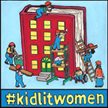
I’m giving a TED TALK!
I’m giving a TED talk! For TedX Beacon Street in Boston. Here’s the information on the live stream:
Title: CAN A CHILDREN’S BOOK CHANGE THE WORLD?
Saturday, Nov. 14 2:00pm EST
My Washington DC adventure!
Wow, what a weekend! It started on Thursday, with a rehearsal of my participation in the Kennedy Center’s Performing Arts Series. This is an amazing series of cultural and artistic performances broadcast live via satellite and web feed FREE to schools nationwide! I went to Hylton High School, part of the Prince William (County) Network, where an impressive broadcast studio is run by students and their advisors. The rehearsal Thursday afternoon was followed by the live performance Friday morning. I was interviewed by Maria Salvadore, professor of children’s literature at the Univ. of Maryland, in front of a studio audience of ninth-graders from Battlefield High School in Haymarket, VA. (Thanks to their teacher Brandie Provanzano for bringing them!) Then I took questions three ways—from the live audience, from phone-in callers, and from real-time e-mailers.
What an innovative program! Check out their website for this season’s schedule, which includes programs on dance, music, and theater as well as literature. And the programs are FREE—all a school has to do is register!
The Performing Arts Series program
Many thanks to Maria, Ginger Rogers and Kenny Neal of the Kennedy Center, and the students and teachers at Hylton for their help with my appearance. I had a terrific time!
I went back to the hotel and got all dressed up for the evening’s event: The National Book Festival’s Opening Gala. This is a black-tie event for the authors and the sponsors of the festival. Here’s a photo of me with my handsome escort, who also happens to be my husband:
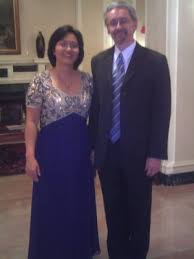
And with our daughter Anna, 16:
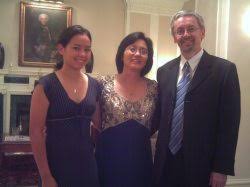
The gala was held at the Library of Congress’s Jefferson Building. A reception in the Great Hall was followed by presentations in the Coolidge Auditorium. The first speaker was Laysha Ward of Target, one of the event’s major sponsors. She was followed by Dr. James Billington, Librarian of Congress, who introduced Laura Bush. Mrs. Bush, a former school librarian, has hosted the National Book Festival since its inception in 2001. She spoke about how the First Book program is raising money to replenish the collections of libraries hit by the recent hurricanes. Then she did a brief introduction of each of the four authors who would be giving presentations that evening. After she sat down, Dr. Billington came back onstage again, to introduce the first author…
*ME*!! I could hardly believe it, but there I was in my sparkly dress (number nine. By which I mean, I had bought and returned EIGHT others…) in front of a very distinguished audience. I spoke about why I write for young people, and as we’d all been asked to read from a recent work, I read a passage from PROJECT MULBERRY. My presentation was followed by appearances from historian David McCullough and novelists Sue Monk Kidd and Tom Wolfe.
My comments at the National Book Festival opening night gala:
I am thrilled and honored and stunned to be part of this wonderful event; thank you, Mrs. Bush and Mr. Billington and Roberta Stevens for inviting me. I have two teenagers at home who see it as their job to keep me firmly down to earth. When I received the incredible news that my book A Single Shard had won the 2002 Newbery Medal, my son’s response was: “Gosh, Mom, think of all those kids all over the country who are going to be forced to read your book now.” Down to earth is mostly a good place to be, but once in a while it’s nice to float off, and standing here in front of such a distinguished audience, I’m really floating. Thank you for being here.
Tonight I’d like to answer a question I’m often asked, which is, ‘Why do you write for children?’ I’m going to imagine that the question has been posed by someone who writes for adults—like this: ‘Why do you write for children?’ And here is my response:
“You’ve published a book for adults? Congratulations, that’s terrific! You know, I bet you want your book to sell a lot of copies, don’t you? And stay in print for longer than one season? I mean, you’d like it to be around for five or ten years or even longer, right?
“Well, I’m working my behind off to make that happen. Yeah, that’s right. I’m doing what I can to help ensure a new generation of readers and um, book-store customers. Because guess what—if they don’t read me now, they’re not gonna read you in the future.
“So the next time you meet a children’s author, someone who devotes their life’s work to creating good literature for kids—you know what you should do? You should fall down on your knees and WORSHIP her!”
So you see, writing for children is for me a way of investing in the future. But the audience for my books is not limited to young people. Teachers, librarians, reviewers, parents, and other caring adults read children’s books. There are also the many wise readers who have made the joyful discovery that a good story is a good story, no matter where it is shelved in the library or bookstore. I guess you could say that I write books for young readers who will one day be adults, and for any reader who was once a child. The Russian author Maxim Gorky nailed it when he said, “You must write for children the same way you write for adults, only better.” I love that challenge….
Children’s authors enjoy a special bond with their readers. We get a LOT of mail. ‘Dear Ms. Park, I loved your book, I have read it fourteen times.’ I think about that often when I write; I try to make every sentence worth reading fourteen times. ‘Dear Ms. Park, I have read all your books, please would you hurry up quick and write some more.’ Who does she think I am, Alexander McCall Smith? ‘Dear Author Linda Sue Park, I’m really sorry because I’m sure you’re a very nice person, but A Single Shard is the boringest book I ever read.’
I hear from adult readers too. Last year I was in Ohio to speak at a conference. Shortly before my presentation, a woman came up to me and asked for a moment of my time. She said she had driven several hours to come hear me speak, and had felt compelled to do so after reading A Single Shard, a novel about an orphan who lives in a potters’ village in 12th century Korea. She had come upon the book during a terrible time in her life, when she was feeling overwhelmed by futility and despair after an ugly divorce. Then she told me through her tears—she was crying, we were both crying—that in the pages of A Single Shard she had found the courage to pick herself up and get going again.
I can tell you in all honesty, I did not write that book as a self-help guide for divorcees. But that is one of the wonderful things about books—how they can take on a life of their own beyond that which their authors gave them. When one of my books gets published, the story is no longer mine alone; it belongs to every reader who values it, no matter what their age.
On a selfish level the reason I write books for children is because I have a blast doing it. I’ve been asked to read from one of my books tonight, and I’ve chosen the start of Chapter One of my latest novel, PROJECT MULBERRY. The narrator is 12-year-old Julia Song, a Korean-American who lives in a suburb of Chicago and whose best friend is a white boy named Patrick.
Patrick and I became friends because of a vegetable.
Not just any vegetable.
A cabbage.
And not just any old cabbage. A Korean pickled cabbage. Which isn’t a round cabbage like Peter Rabbit would eat, but a longer, leafier kind. It gets cut up and salted and packed in big jars with lots of garlic, green onions, and hot red pepper, and then it’s called kimchee. Kimchee is really spicy. Koreans eat it for breakfast, lunch, and dinner.
I don’t like kimchee. My mom says that when I was little, I used to eat it. She’d rinse off the spiciness and give me a bite or two. When I got to be six or seven years old, she stopped rinsing it. Most Korean mothers do that, and most Korean kids keep eating it.
Not me. I hated the spiciness, and I still do. My mom keeps telling me I should eat it because it’s refreshing. But what’s so refreshing about having your mouth on fire?
My family used to tease me about not liking kimchee. My dad said maybe it meant I wasn’t really Korean. “We should have your DNA tested,” he’d tell me. The seven-year-old snotbrain named Kenny who lives with us—otherwise known as my little brother—would wave big pieces in front of me and threaten to force me to eat them.
Another thing about kimchee is, it has a really strong smell. Even though it’s stored in jars, you can still smell it, right through the jar and the refrigerator door. It sends out these feelers through the whole house.
Three years ago when I was in fourth grade, we were living in Chicago. I’d made friends with a girl named Sarah. The first time she came over to play, she stopped dead in the entryway and said, “Ewwwwww! What’s that smell!??”
I’d never really noticed it. Smells are funny that way—they can sort of disappear if you live with them all the time. But Sarah was so grossed out that I was really embarrassed.
I asked my mom to stop making kimchee, but she told me I was being unreasonable.
I met Patrick two years ago, on our second day in Plainfield, a Saturday morning. He came down the steps of his front porch and said hello and told me his name. I said hi back and told him mine.
“Can I see inside your house?” he asked.
“Sure,” I said.
As we walked in the door, Patrick tilted his head and sniffed.
I braced myself for his reaction.
“Whoa,” he said. “What’s that? It smells great!“
That was the beginning of Patrick’s love affair with kimchee. Whenever he eats dinner with us, my mom puts one bowl of kimchee on the table for the family and gives Patrick a whole private bowl for himself. He eats it in huge mouthfuls, sometimes without even adding any rice. I can hardly stand to watch him.
Maybe he’s the one who needs his DNA tested.
(End of reading)
The National Book Festival was started by a visionary librarian—a children’s librarian—who happens to have some pretty good connections. The festival is for me an embodiment of the power of stories and books to link the past with the future. It also honors the institutions which preserve and share the collected wisdom of the ages—our libraries, especially this amazing Library of Congress. I hope all of you share my wish: May this wonderful event endure and become one of our country’s most cherished traditions.
* ~ * ~ * ~ * ~ *
I got to chat a bit with Sue Monk Kidd backstage and really enjoyed talking with her. I also learned that David McCullough is a big fan of classic children’s literature! The most frustrating part of the evening was being backstage during the other presenters’ talks—I couldn’t hear them. But the event was broadcast on C-Span’s BookTV, and will also be archived as a webcast on the Library of Congress website, so I hope to be able to hear them very soon. (I’ll post again when the feed is available.)
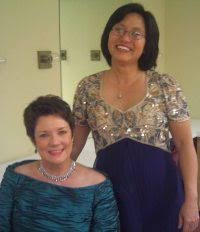

After the speeches, we moved to the mezzanine for dinner. I had a wonderful time speaking to several of the guests. Steve and Cokie Roberts! Dikembe Mutombo of the Houston Rockets! ‘Trading Spaces’ designer Laurie Smith! Authors Sharon Creech and Patricia Reilly Giff and Pat Mora and Jack Gantos (hurrah for the ‘home team’!)! Authors David Baldacci and Jeffrey Deaver and poet Dana Gioia! Former NBA legend and now reading ambassador Bob Lanier! Even Secretary of State Condoleeza Rice (talk about surreal…)! As if I weren’t dazzled enough just meeting these folks, they were all kind enough to tell me how much they had enjoyed my presentation.
An interesting moment: I was taken aside and interviewed briefly by a New York Times reporter, who was gathering responses from authors on a couple of controversies. There was an anti-war demonstration scheduled for the next day; it would take place within a stone’s throw of the festival. Also, a day earlier, The Nation magazine had published a letter from poet Sharon Olds which explained that she was pulling out of the festival as a way of protesting the war and the current administration.
The reporter wanted my comments. I said I was there to support the festival—that I wanted it to last forever, no matter who was in the White House. My comments were not used in the article, but most of the other authors who were quoted expressed similar thoughts.
On Saturday, the day of the festival itself, it became clear that many of the protesters did not share Ms. Olds’ sentiments; they wandered from the demonstration to the festival (where you could in fact buy books in every color of the political spectrum…) and back again. I was pleased that my teenage daughter got to see such a striking example of democracy in action—a peaceful protest, an official festival, side by side. She also got to hear Joan Baez—Joan Baez—sing!! (There was a concert at the Washington monument, part of the protest.)
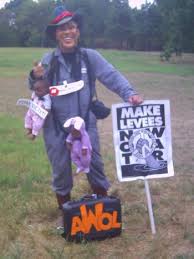
In my presentation I talked about PROJECT MULBERRY and read my new picture book BEE-BIM BOP as well. I had a wonderful audience—thanks to everyone who attended my session, a real honor with so many other choices at the festival! And my signing afterwards was wild—I was one of a dozen authors in that time slot, the last one of the day. I had to stay 15 minutes after everyone else was finished—the festival was over, they were starting to break it down, and the only thing that was still going on was me signing for those patient folks who had stood in line for me all that time!
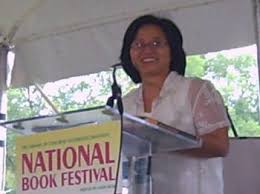
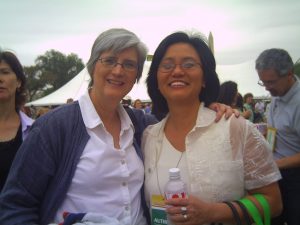
It was a busy day, but I did get to hear at least part of the presentations by authors Rene Saldana and Pat Mora. As always, my favorite part was the opportunity to meet so many of my readers—thrilling and humbling at the same time. Like the boy (I think his name is Daniel), who announced to the staff helping out at the signing: “I can’t believe it—I’m about to meet my favorite author!” and then told me he had read SHARD maybe 50 times (“I lost count,” he said…).
It doesn’t get any better than that.
July 2002 – Newbery Award!
Newbery Award Banquet!
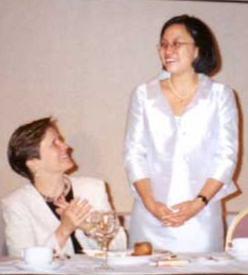
For this month, there’s just one update, but it’s a big one: a report on the American Library Association Annual Conference held in Atlanta in June. Hope you enjoy it!
2002 American Library Association
Annual Conference
Atlanta, Georgia
Friday, June 14
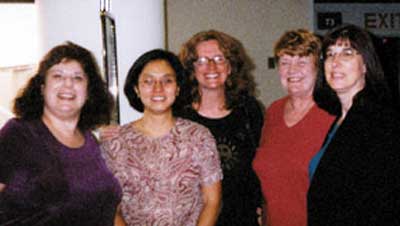
The trip through Wonderland began right at the Rochester airport, because authors Mary Jane Auch, Roxane Chadwick, Marsha Hayles, and Vivian Vande Velde were on the same plane as me. We didn’t get to sit together, but it was still great to chat with them at both ends of the flight. In Atlanta, my first ‘event’ was lunch (spinach and goat cheese grits) at the Ritz with my genius editor Dinah Stevenson. As many of you know, Dinah edited both A Single Shard and David Wiesner’s Caldecott Medal book, The Three Pigs. She is only the sixth editor in the history of the awards to have edited both Medal books in the same year — so more than anyone else, it was her weekend to shine!
Later that afternoon, a group of online friends threw a corker of a party at the Georgian Terrace, hosted by Susan Taylor Brown, Ann Mannheimer, and Patricia McMahon in their huge and incredibly elegant suite.
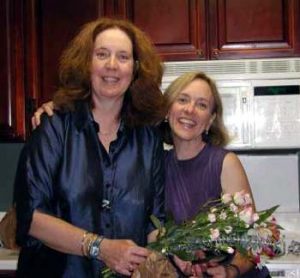
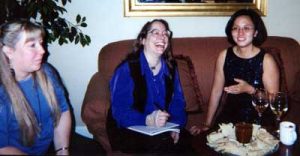

More partiers: Toni Buzzeo, Jennifer Jacobson, Franny Billingsley.
As if wine, food, and friends weren’t enough, the group then presented me with the most amazing gift. I opened a beautifully wrapped box to find another box inside (don’t you just love that) — a wooden one, with a silver plate on top inscribed with the words, “Like Jade Like Water,” which is based on a line from A Single Shard. Inside the box there was a little silk pouch (don’t you just LOVE that!??) containing a pendant on a silver chain.
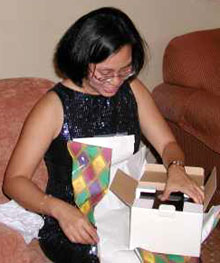
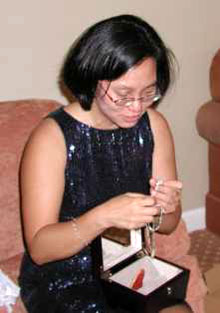

And wonder of wonders, the pendant is a single shard.

A shard of Korean Celadon, no less. The pendant had been brought from Korea by Patricia years ago, on her return after living in Seoul. She told me that it was waiting for me all that time-but I am still in awe of her parting with it. I wish the photos could do it justice, but you simply cannot get an idea of how beautiful it is unless you see it in real life.
From the party to dinner with The Posse, as they came to call themselves, a la P. Diddy’s entourage — my critique partner Marsha Hayles, and two friends I’ve known for years, Nancy Quade and Kathleen Cotter. Kathleen is a librarian in Great Neck, NY, and Nancy used to be one, but she isn’t anymore — she came to ALA just to be with me. We ate at a restaurant called Mumbo Jumbo, which I booked because of the name — it sounded very Wonderlandish. (It was good, too. I had grits again. I like grits.)
Afterwards, a dessert affair for Listening Library at the Four Seasons hotel, where Tim Ditlow and Cheryl Herman took good care of me. I got to meet one of my heroes, Virginia Euwer Wolff!
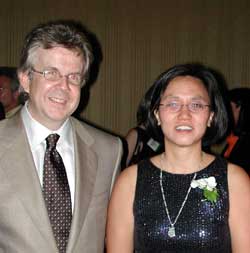
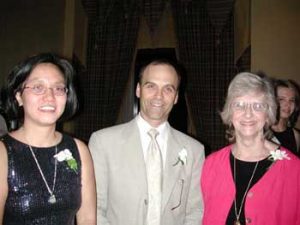
After the party, Nancy and Kathleen forced me to have a drink with them in the Four Seasons bar (What’s that—it was my idea?? Are you sure? I don’t rightly recall. . .), so the day ended on a very merry note.
I was somewhat less merry the next morning. . .
Saturday, June 15
The wake-up call jangled the inner core of my brain at 6 a.m.: Clarion’s kick-off breakfast would begin in an hour. I had, um, a little headache. I’d planned to wear my chima-chogori (traditional Korean dress and jacket) to the breakfast, but that plan almost came undone. I was sharing my room with Marsha for the one night, until my family arrived later that day, and I didn’t want to disturb her by turning on all the lights. So I struggled into the garments, which do not button or zip or snap; instead there is a complicated system of narrow slippery ribbons to be crossed and wrapped and tied. This is not easy to do when you hardly ever wear the thing, and the room is dark, and you have a little headache.
After several attempts, I gave up, praying that my final groping effort would keep the clothes on me somehow, and made my way to the elevators; thank goodness the event was being held in my hotel. All of Clarion was at the door of the ballroom to meet me, and immediately I began to feel much better. I have to confess, though, that having flash bulbs go off repeatedly at that hour of the morning as your photo is taken several times does not make a little headache any smaller. I met some lovely people there, including Andrea Davis Pinkney, new head of children’s publishing for Houghton Mifflin (of which Clarion is an imprint), whose work as both author and editor is inspiring.

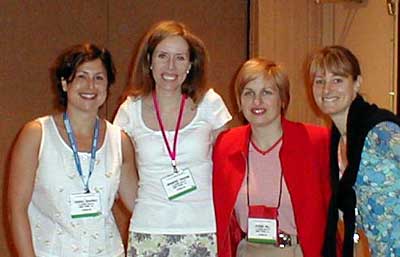
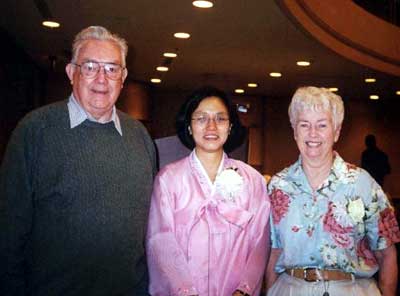
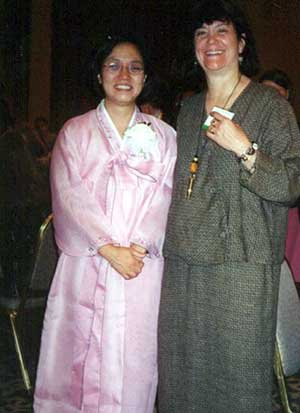
From the breakfast to a waiting car that took me and David Wiesner and Deb Shapiro (then of Clarion’s marketing department, now of Simon & Schuster, and boy do I miss her!) to Hobbit Hall bookstore in suburban Atlanta. What a great place! A nice crowd of kids and parents, and best of all, I got to see David’s presentation, in which he showed the stages of the work for The Three Pigs. A terrific lunch at the Buckhead Diner (fried green tomatoes for the first time, and meatloaf, and mashed potatoes to die for); stock signing at another store –Chapter Eleven (“Books so cheap you’ll think we’re going out of business”); and back to the hotel at around 3:30, where I met up with my family.
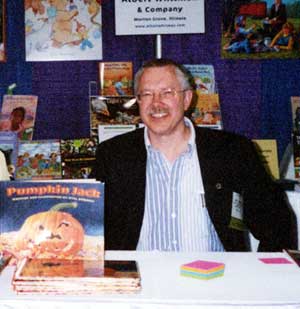
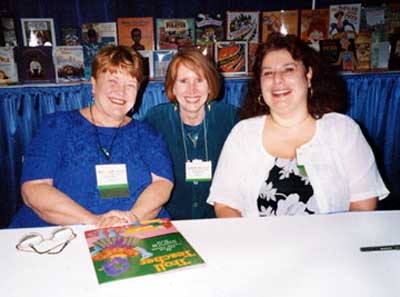
At 6:00, Random House had a cocktail party at the Margaret Mitchell House, which is now a museum. Adrienne Waintraub did a wonderful job running the party — great food, my son must have eaten at least a couple dozen of the coconut butterflied shrimp! One room of the house has a wonderful display of letters Mitchell wrote during and after the writing of Gone With The Wind. I wish I’d had more time to read them, and will definitely go back the next time I’m in Atlanta. I got to meet UberEditor Wendy Lamb and another of my heroes, author Peter Dickinson. Dinner at a Chinese restaurant with The Clan — my husband and two children; my parents; my brother and his wife and my niece and nephew (Emma and Craig, who are pictured elsewhere on this site); and Nancy and Kathleen. And the day finished up with another drink with The Posse (We Value Consistency).
Sunday, June 16: Part 1
Breakfast (grits, of course—what did you expect??) with Kimberly Willis Holt, author of the Boston Globe/Horn Book Honor title My Louisiana Sky and National Book Award winner When Zachary Beaver Came to Town. Kimberly was one of the very first people I ‘met’ online five years ago, and she has been unfailingly kind and helpful ever since. We had a lovely visit, but drat, I didn’t have a photo taken with her. Hopefully we’ll meet up again soon so I can remedy that.
My first signing in the exhibit hall, for Listening Library. It was fun meeting so many people who love books! The highlight: Meeting the members of the Eva Perry Newbery Club from North Carolina — thirty-five kids on a field trip to ALA, what a terrific idea!
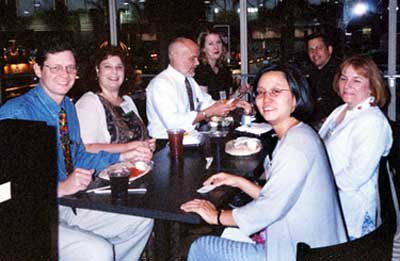
Meanwhile, my family was having fun in Atlanta without me:
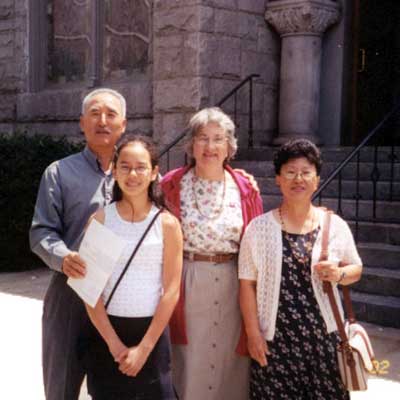
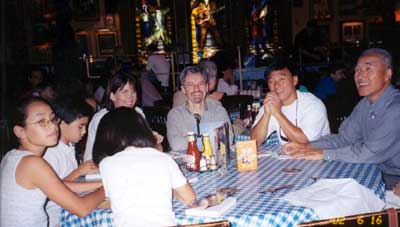
Then it was off to a lunch arranged by my agent Ginger Knowlton with authors Susan Campbell Bartoletti (winner of this year’s Sibert nonfiction award for Black Potatoes), Nancy Werlin (Black Mirror and many others), and Dian Curtis Regan (Princess Nevermore and many others!), at a place called South City Kitchen. A salad and chicken livers (yum) and great conversation.
Sunday, June 16: Part 2
Back to the exhibit hall for my first Clarion signing. As I got near the booth, I passed what I thought was a long conga line . . . it turned out to be people waiting for my signing, good grief! What a treat to meet librarians from all over the country; I loved finding out where they were from and only wish I could have spent more time chatting.
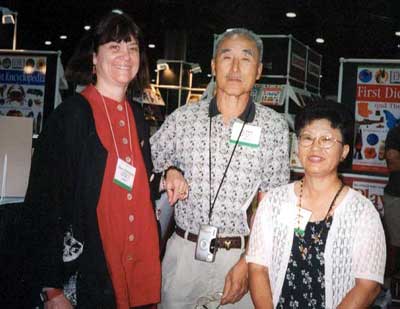
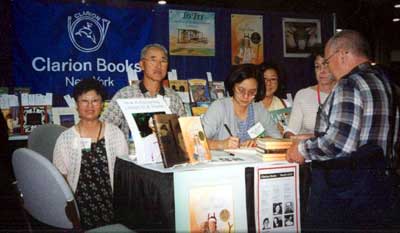
The signing finished at 3:30; back to the hotel for a little rest, then spiffying-up for the Newbery-Caldecott banquet. Gulp.
Sunday, June 16: Part 3
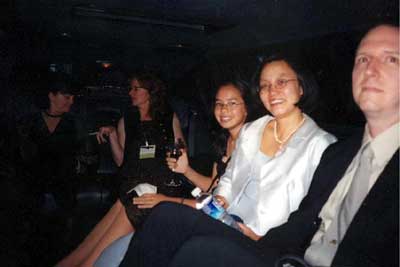
I’ve gotten a lot of questions about what I wore—believe me, finding the right dress was as difficult as writing the speech! The dress was ice blue, almost silver, spaghetti straps, very straight and simple, with a little beading here and there in two tones of pink, and a matching jacket, also beaded. The ballroom lighting had an interesting effect on the color—I heard some accounts that the dress was pale green and others that it was ivory. I wore the pearls my mother had given me as a wedding present, with a pendant of pink topaz that had been made for the occasion. Although I did a fair bit of agonizing over what to
When I entered the banquet hall, I was taken aback to see two gigantic screens flanking the dais; I had not been warned that each of my pores would be magnified to the size of a quarter. . . Thankfully, I couldn’t see the screens while I spoke. I am pleased to report that dinner was not rubber chicken; it was salmon and filet mignon, and although I was too nervous to eat much, what I did eat was very tasty. Impressive, considering that at least a thousand meals were being served.
Carole Fiore, president of the Association of Library Service for Children, opened the award presentation. Kathleen Odean, chair of this year’s Newbery Award Selection committee, spoke next and presented plaques to Honor winners Polly Horvath (for Everything on a Waffle) and Marilyn Nelson (Carver: A Life in Poems)—both MUST-READS, in my opinion. Then Kathleen introduced me and gave me the Newbery Medal in a beautiful wooden box. (I’m getting goosebumps just typing that. . .) I loved Kathleen’s introductory remarks, and she has graciously given me permission to reprint them here.”
Kathleen Odean’s Award Comments
The text of my speech is available in the July/August issue of Horn Book magazine. I’m grateful to all those who spoke to me afterwards, telling me how much they had enjoyed hearing it. Speechwriting and speechgiving are new for me, so the kind comments were greatly appreciated. And yes, it’s true that I presented the Medal to my father. It was, after all, Father’s Day, and I am very grateful that both
Caldecott committee chair Kate McClellan spoke next and presented plaques to Bryan Collier (Martin’s Big Words, text by Doreen Rappaport); Bryan Selznick (The Dinosaurs of Waterhouse Hawkins, text by Barbara Kerley); and Marc Simont (The Stray Dog). Then she gave the Caldecott Medal to David Wiesner, who now has a remarkable collection-two Caldecott Medals (for The Three Pigs this year and for Tuesday in 1992) and two Honors (Sector 7, 2000 and Free Fall, 1989). David’s speech, also available in the July/August Horn Book, gave great insight into his artistic vision and process. He also did the fabulous cover of that issue—check it out at the Horn Book website and see if you can spot the joke.
Banquet photos:
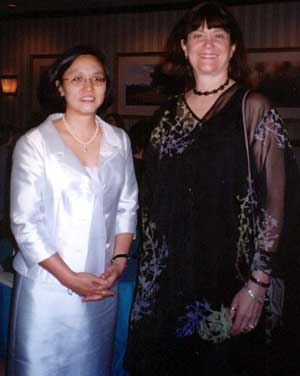
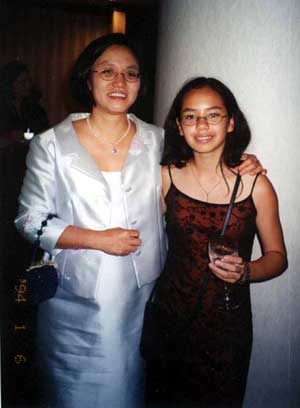

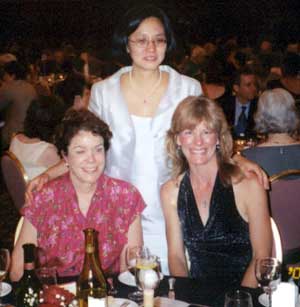
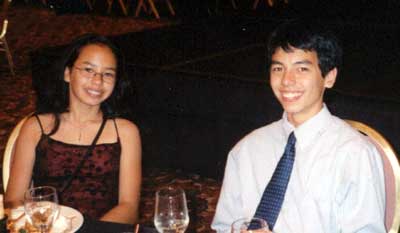
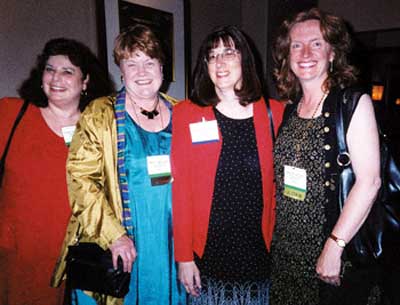
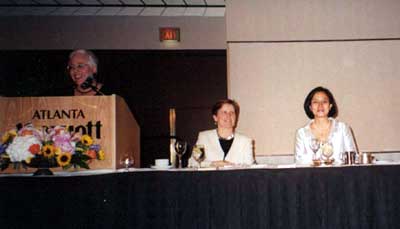
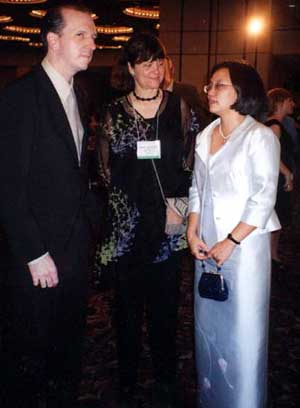
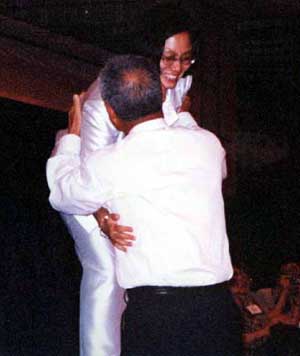


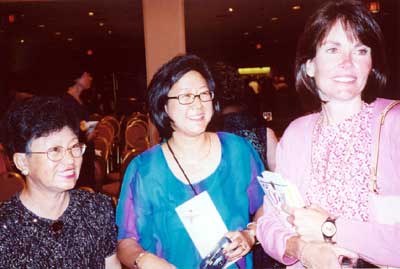
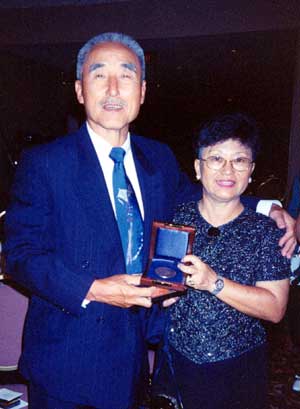
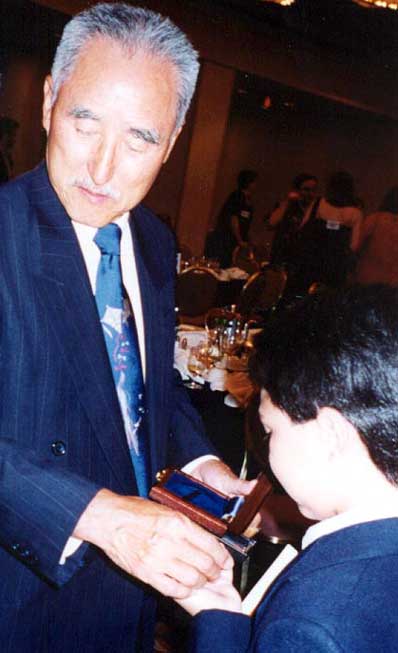
After the speeches, a long receiving line—another wonderful opportunity to meet librarians from all over the country.

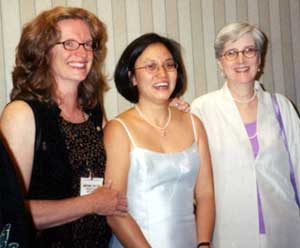
Monday, June 17
Another signing for Clarion Monday morning, a quick bite to eat with Dinah, and then on to dessert with a group of writers and librarians, where we laughed until our sides ached. The day finished with a dinner given by Clarion for the Newbery committee, my parents, and me. It was held in a private room at the Ritz. I got to change seats with every course so I had a chance to visit with everyone. With the speech behind me, I felt relaxed and so happy to be able to chat with the committee members. It was a perfect evening.
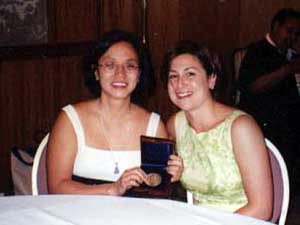
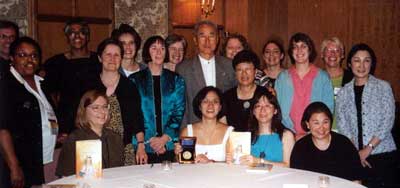
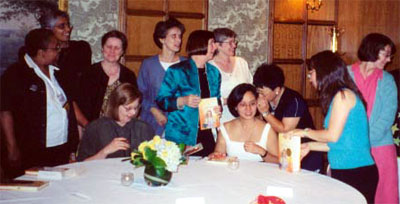
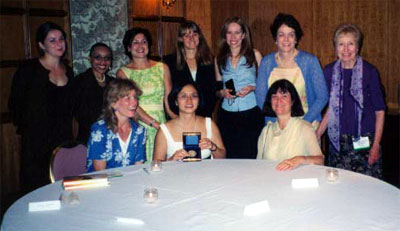
Tuesday, June 18
Tuesday morning I was privileged to attend the Coretta Scott King Award breakfast. Award recipient Mildred Taylor (for The Land) was unable to attend, so her editor Phyllis Fogelman read the speech Ms. Taylor had prepared. Fiction Honor winners Marilyn Nelson (Carver) and Sharon Flake (Money-Hungry) also spoke, as well as the illustration winners: Jerry Pinkney, Award for Goin’ Someplace Special-a book I LOVE-and Bryan Collier, Honor for Martin’s Big Words; and Jerrome Larrigue, John Steptoe New Talent Award recipient (for Freedom Summer, text by Deborah Wiles). There was a warm and celebratory spirit at this event and I enjoyed it immensely.
As well as hearing the winners speak, Mrs. King herself addressed the audience. It was truly thrilling to hear her, and I couldn’t have picked a better way for my magical weekend to finish.
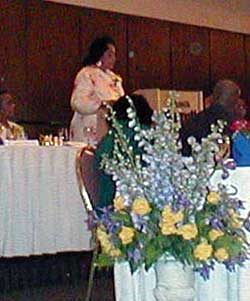
I flew home Tuesday afternoon, replete with memories of my magical time at ALA. A gazillion thanks to all who attended, and all who were there in spirit!
Photo credits: Lynne Polvino, JoAnn Hill, Ed Park, Ben Dobbin, Kay Winters, Julie Hubble, JoAnn Jonas
